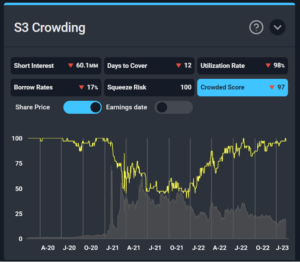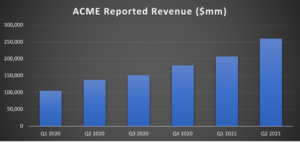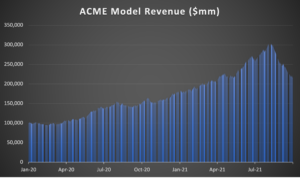10 min read
Idea Generation Powered by Alternative Data
Introduction
Hedge Fund Crowding continues to be a primary concern for institutional investors. One apparent reason for crowding into the same names is a similarity in the process of screening and stock selection among hedge fund managers. Given that backdrop, it is more important than ever for PMs and analysts to generate, research, and invest in not only profitable but unique ideas. To address this, some managers are turning away from the established ways of screening for new ideas and instead are tapping data to increase both profitability and uniqueness.
The established Idea Generation process is a natural source of crowding.
Even though there are hundreds of different hedged strategies, there seems to be a convergence in the process of generating new ideas. The process usually involves several common steps.
First, there are regular company management meetings, where admittedly, the CEO / CFO may not always be completely transparent and forthcoming with the investors in the room. Then, there are the sell-side conferences hosted by large financial institutions, which may also be conflicted, since they profit from lucrative relationships with large corporations.
There is also sell-side research that many managers rely on to get a better understanding of the company’s positioning and prospects. And, of course, another reliable source of ideas is the network of buy-side friends and former colleagues that managers can call on to talk about the new names they may be looking into at the time. Finally, managers use financial data to screen for stocks that pass specific criteria, for example, “cheap stocks that are experiencing revenue growth” or “consumer sector stocks experiencing revenue declines.”
All these well-trodden sources lead to an echo chamber of sorts in the community and cause managers to pile into the same stocks on the long and short sides, squeezing out liquidity and influencing price. Most notably, on the short side, crowded trades can cause much damage to managers and their investors. Take, for instance, the “Meme-stock” debacle of 2021. Massively crowded short positions in GME and AMC led to billions in losses to managers and their LPs.

Source: Maiden Century IDEA Platform, S3
Thankfully, this is a problem that Alternative Data can help with. Instead of solely relying on the established process and traditional valuation metrics for stock screening, some managers are avoiding the crowds by tapping into Alternative Data sources to surface unique ideas well before the market catches on. In this article, we describe the advantages Alternative Data can offer a fund manager on the prowl for fresh ideas, and how Alternative Data can be a valuable resource for unique idea generation.
High frequency and Granularity of Alterative Data Provide an advantage.
The two clear reasons why managers use Alternative Data are frequency and timeliness of the data. While public companies report KPIs such as Revenues on a quarterly basis, managers can build models estimating revenues (and other KPIs) daily. On top of that, they can refresh estimates from their model with data on just a few days’ lag, versus waiting four to eight weeks for a company to announce their latest quarter results. Consider this when you need to estimate sales around holidays, Black Friday, or the launch of a new product: You could be analyzing Valentine’s Day sales on February 20th, while the rest of the market has to wait several more weeks. Data released at a low frequency and high lag can mask significant inflections in consumer behavior and can obscure signals that could potentially be used for idea generation.
Let’s say you are screening for short candidates in the consumer sector that show an inflection point in revenues – more specifically, you’d like to see the companies that have had historically strong growth but are most recently experiencing a slow-down or decline in revenues. Now, consider this hypothetical example of ACME company’s quarterly reported Revenues.

Source: Maiden Century, hypothetical data
By the looks of it, the revenues are increasing steadily, and the trend seems persistent. Consequently, this stock would not show up in your screen for decelerating growth simply due to the lag in ACME’s reporting.
Now, assume you have a good model of ACMEs revenues based on a combination of credit card and debit card spending data. This data updates on a 5-day lag and has daily frequency.

Source: Maiden Century, hypothetical data
Now, studying the modeled revenue on a granular level and on a five-day lag, an inflection can become evident. If you are running a screen on revenue deceleration, this name will show up.
Being early to spot this type of trend change can mean the difference between a profitable and a losing trade. Having the right data at your fingertips means you can identify and research your short candidates sooner and, more importantly, you can pursue profitable trades that are not yet crowded.
KPIs that are not reported can add value to your Idea Generation.
Another important feature of Alternative Data is the ability for managers to run a screen on KPIs that a public company may not report in the first place.
For instance, you may want to narrow your “revenue deceleration” screen down to companies that are also experiencing a drop-off in customer engagement on the website and their most popular customer-facing app.
Using multiple data types and different KPIs for screening allows managers to get creative with idea-generation themes and can surface candidates they would have never identified otherwise.
In addition, combining orthogonal datasets may strengthen your conviction in a new idea and give you a more focused list of candidates to research further.
Can data itself lead to more crowding?
As more managers bring data into their process, and more investors tap data for idea generation, there is a question of whether the data itself can contribute to crowding.
This would be true if there were only one dominant data set and just one way to interpret the data. That’s far from being the case. Data does not have the opinionated view of a sell-side analyst, it is agnostic and neutral by definition. Two managers looking at the same dataset can build different models and come away with a different story on the stock. Add to this the aggregation of dozens of different datasets, combining them each with differing weights, adjusting the data for biases, and finally, constructing different screening criteria – all of which lead to a significant diversion in potential outcomes. As more and more data becomes available to investors, the opportunity for unique idea generation only increases.
Looking to Learn More?
Every investment process is different. To learn how Alternative Data can empower new idea generation in your organization, reach out to us at: hello@maidencentury.com